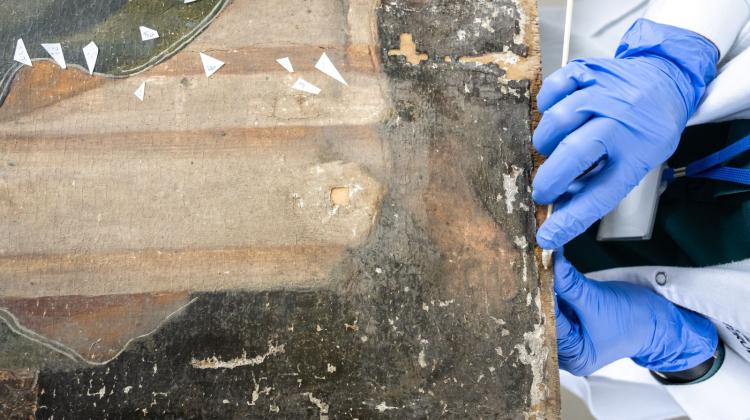Innovative brain tumour treatment performed by Polish specialists
 Photo: Fotolia
Photo: Fotolia
The world's first intravascular administration of a drug to a malignant brain tumour under magnetic resonance has been performed by specialists from the Central Clinical Hospital of the Ministry of Interior and Administration in Warsaw.
Dr. Michał Zawadzki from the hospital of the Ministry of Interior and Administration in Warsaw and Prof. Mirosław Janowski from Johns Hopkins University in the US, who performed the procedure, say that this method could revolutionize the treatment of brain tumours.
The pioneering procedure took place in the second half of November 2017 at the Department of Radiology of the Ministry of Interior and Administration in Warsaw, headed by Prof. Jerzy Walecki. It was reported only now, when it became clear that the malignant tumour began to significantly shrink after the procedure. In the control resonance test, it decreased by 5 mm after just three days.
The treatment was administered to a 39-year-old patient admitted to the Department of Neurosurgery of the hospital of the Ministry of Interior and Administration headed by Dr. Bogusław Kostkiewicz, with recurrent glioblastoma multiforme - an extremely malignant brain tumour. According to doctors, earlier neurosurgical surgery, radiation and chemotherapy were unsuccessful. The tumour was so aggressive that it grew almost a millimetre per day.
Dr. Michał Zawadzki and professor Mirosław Janowski from Johns Hopkins University decided that the only chance was to administer the drug directly to the tumour arteries under magnetic resonance. Due to the rapidly deteriorating condition of the patient, the doctors applied to the Bioethics Committee and Hospital Director for permission to perform the procedure.
This type of surgery was previously performed only in animals and never before in humans. It was developed in the US by Polish professors Mirosław Janowski and Piotr Walczak together with doctor Monika Pearl.
"In experimental studies we have shown that even a small change in the position of the catheter or the speed of drug delivery can dramatically change the area of its action" - explained Prof. Janowski. "When we administer the drug through the catheter only under X-ray control, we can also deliver it where it is not needed and not only fail to help the patient, but also expose him or her to complications" - he said.
Doctor Zawadzki pointed out that magnetic resonance helps to administer the drug exactly where it is needed. "The tumour itself is often not visible in classic X-ray angiography, and resonance shows us exactly where it is" - he added.
The specialist carried out similar experimental procedures on animals. At the Central Clinical Hospital of the Ministry of Interior and Administration in Warsaw, he performs endovascular brain surgery, including embolization of aneurysms and haemangiomas.
The intravascular administration of the drug was performed via a small puncture in the groin. Under X-ray angiography doctors introduced a tiny catheter (diameter approx. 0.4 mm) through which they administered mannitol (to unseal the blood-brain barrier) and then bevacizumab (monoclonal antibody blocking tumour vessels - PAP).
Dr. Zawadzki emphasized that the procedure was very difficult, because the tumour was supplied by as many as four vessels (usually it is one or two arteries).
"We managed to administer the drug to three arteries under X-ray control, but in order to administer it to the largest, fourth artery, it was necessary to transfer the patient to a magnetic resonance. Only there, by giving contrast through the microcatheter at different speeds, we have seen how the drug would spread in the tumour and the surrounding brain area" - explained the specialist.
Dr. Zawadzki added that the use of this method allowed to determine the optimal position of the microcatheter and the speed of drug administration, in order to administer the drug directly to the tumour and minimize toxic effects on other parts of the brain. "In resonance, we are also able to visualize the unsealing of the blood-brain barrier after administration of mannitol and thus optimise the time of administration of the drug so that it reaches the tumour" - he said.
Four days after the surgery, the patient returned home. Doctors assure that her condition is clearly improving. "We hope that the tumour will continue to decrease and that the patient will have time for introducing other methods of treatment" - said Dr. Zawadzki.
Prof. Janowski said that immunotherapy (stimulation of the patient\'s immune system to destroy tumour cells) has promising results in experimental and clinical studies. "We are considering using of this method also in our patient, but for this to become possible, the tumour must shrink significantly" - he added.
Professor Jerzy Walecki said that glioblastoma multiforme is a particularly difficult disease to treat. "Every innovative method that gives hope for improvement of results must be quickly implemented" - he stressed. (PAP)
PAP - Science in Poland
zbw/ ekr/ kap/
tr. RL
Przed dodaniem komentarza prosimy o zapoznanie z Regulaminem forum serwisu Nauka w Polsce.

















